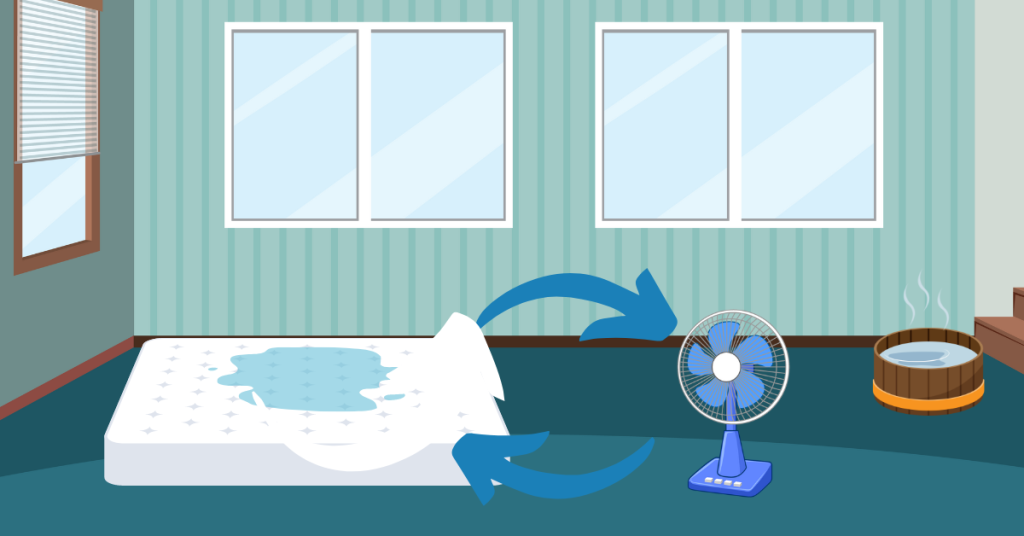
How to Dry a Mattress?
From air drying to advanced techniques, find the perfect method to dry your mattress in our top ten list!
Drying a mattress is important to keep it clean and prevent mold. When we spill liquids or sweat, it can make the mattress wet. A wet mattress is not good for sleeping because it can smell bad and make us sick. Drying it helps keep it fresh and comfortable for sleeping. It’s like giving our mattress a bath to keep it healthy and last longer. Knowing how to dry a mattress is helpful when accidents happen, so we can fix it quickly and stay cozy while we sleep.
Table of Contents
ToggleWhat happens if we don't dry a wet mattress?
- Mold and mildew can grow.
- Bad odor develops.
- Stains may set in permanently.
- Fabric may degrade faster.
- It becomes a breeding ground for bacteria.
Methods to Dry a Wet Mattress:
Drying a mattress can be a bit of a challenge, but it’s definitely doable! Here are several methods you can try.
Sunshine and Fresh Air Method:
- Take your mattress outside on a sunny day.
- Lay it flat on a clean surface, preferably on a clean sheet or tarp.
- Let it soak up the sun’s rays for several hours.
- Flip the mattress over halfway through to ensure both sides dry evenly.
- Make sure the weather is dry and not too humid for this method to work effectively.
Using a Fan:
- Place the mattress in a well-ventilated room.
- Set up a fan near the mattress.
- Turn the fan on to its highest setting and point it directly at the mattress.
- Let the fan blow air over the mattress surface for several hours or until it’s completely dry.
- Rotate the mattress periodically for even drying.
Dehumidifier Method:
- If the weather is too humid for air-drying, use a dehumidifier indoors.
- Place the dehumidifier in the room with the mattress.
- Turn it on and let it run for several hours or overnight.
- The dehumidifier will help remove excess moisture from the air, aiding in the drying process.
Baking Soda Absorption:
- Sprinkle a generous amount of baking soda over the surface of the damp mattress.
- Let it sit for several hours or overnight.
- Baking soda helps absorb moisture and odors from the mattress.
- Vacuum the baking soda off the mattress using a vacuum cleaner with an upholstery attachment.
Using Towels:
- Lay clean towels over the wet areas of the mattress.
- Press down gently to absorb as much moisture as possible.
- Replace the towels with dry ones as needed until the mattress feels damp rather than wet.
- Continue with air-drying methods like using a fan or dehumidifier to complete the drying process.
Hair Dryer Technique:
- Set your hair dryer to the lowest heat setting.
- Hold it a few inches away from the wet areas of the mattress.
- Move the hair dryer back and forth over the surface, focusing on one section at a time.
- Be patient and avoid overheating or damaging the mattress with high heat.
Using Absorbent Materials:
- Place absorbent materials like clean towels, blankets, or even newspaper underneath the wet areas of the mattress.
- These materials will help soak up excess moisture from the mattress.
- Replace them with dry ones as needed until the mattress is mostly dry.
Ventilation:
- Open windows and doors in the room to promote air circulation.
- This will help speed up the drying process by allowing moisture to escape.
Elevating the Mattress:
- Prop up the mattress against a wall or sturdy surface in a well-ventilated area.
- This allows air to flow around both sides of the mattress, aiding in drying.
- Rotate the mattress periodically to ensure even drying.
Using a Wet-Dry Vacuum:
- If the mattress is soaked, use a wet-dry vacuum to extract excess moisture.
- Run the vacuum over the surface of the mattress, focusing on wet areas.
- Empty the vacuum’s collection tank as needed until no more moisture is being extracted.
Remember, it’s essential to ensure the mattress is completely dry to prevent mold and mildew growth. Patience is key, as drying may take several hours or even days depending on the method used and the extent of moisture in the mattress.
Did you know?
How to dry a mattress quickly?
To dry a mattress fast, use fans, open windows, and sunlight. Blot moisture with towels, then air it out for quicker drying. extra layer of protection against wear and tear.
Frequently Asked Questions
A wet mattress can grow mold & smell bad if not dried properly. Quick action & thorough drying can save it from damage.
A mattress protector or waterproof cover absorbs moisture from a mattress, keeping it clean and dry.
Drying time for a mattress varies based on material and conditions. Typically, it can take 24-48 hours to dry completely.
